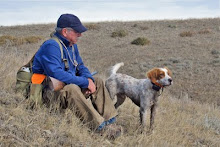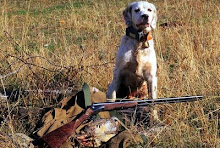Dr. Charlie Hjerpe with 2X CH Sand Creek Bud
A couple of months ago, Charlie sent me a copy of a longer article that he had written about Hunting Dog Hypoglycemia. Great information, including some little known information about nutrition and fitness, but a little too long for a blog post. At my request, Charlie boiled it down to the following article. A big thank you to Charlie for this very valuable contribution...
Some Personal Observations, Opinions, Hypotheses, and a Little Science Concerning Hunting Dog Hypoglycemia (HDH)
by Dr. C.A. Hjerpe, DVM - Davis, California
A. INTRODUCTION:
Before discussing my personal observations of and opinions concerning hypoglycemia in hunting dogs, I will first offer some disclaimers, present my credentials and provide some definitions. First, I wish to emphasize that I am not and have never been a small animal specialist, and my personal observations and opinions are based on recollections that are not backed up with detailed, written records, and should not be regarded as “research”.
I graduated from Cornell University’s New York State College of Veterinary Medicine in 1958, worked in private, mixed species veterinary practices for 5 years, and was a professor of large animal medicine at the School of Veterinary Medicine, University of California, Davis, for 31 years, until retiring in 1994. During the last 14 years of my academic career, I also served as Director of the UCD Veterinary Medical Teaching Hospital. During the past 48 years, I have owned one Weimaraner, 2 English setters and more English pointers than I would be able to recall and enumerate (probably more than 100). I have field trialed with most of these pointers, and have always hunted with my field trial dogs.
B. DEFINITIONS:
I think it appropriate to begin this presentation with a short discussion of hypoglycemia. When veterinarians or physicians say that a dog (or cow or person) is hypoglycemic, we are saying that the concentration of glucose (a specific type of sugar compound) in the blood of that individual is below the normal range for blood glucose values in that species. For a dog, it means that the patient’s blood glucose concentration is less than 59.4 milligrams per deciliter (mg/dl).









